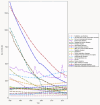Transforming health in Nepal: a historical and contemporary review on disease burden, health system challenges, and innovations
- PMID: 40394610
- PMCID: PMC12090584
- DOI: 10.1186/s12961-025-01321-z
Transforming health in Nepal: a historical and contemporary review on disease burden, health system challenges, and innovations
Abstract
Introduction: Nepal witnessed a tumultuous journey over past two centuries, marked by significant political, social, and cultural shifts. From fighting British colonial encroachments in 1800s, the dynastic Rana regime (1846-1951), and democracy movements in the late 1950s, 1990s and 2000s, Nepal became a federal republic in 2008. The main objective of this review is to lay out an interpretative summary on Nepal's epidemiological transition (includes general trends and disease specific topics) followed by discussion on health system development over key periods: historical period (-1950s), modern period (1950-1990), post-democracy (1991-2016), and post-federalization (2016-).
Methods: We conducted a scoping review of available literature using the Arksey and O'Malley framework to synthesize the key insights. Searches were performed in PubMed (via NLM), Embase and Google Scholar using a combination of search terms related to Nepal's health system, epidemiological transition, disease burden and emerging health issues. A total of 1204 records were identified, of which 123 documents - including peer-reviewed articles, government reports and grey literature - met the inclusion criteria.
Results: Major advances in maternal and child health, nutritional health and reduction of infectious diseases have been observed in recent decades. The maternal mortality ratio (MMR) declined by 55% (1996-2016), and neonatal mortality halved (40 to 20 per 1000 live births) due to improved antenatal care, skilled birth attendance and family planning. Stunting rates fell from 66% (1996) to 25% (2022), yet rising non-communicable diseases (NCDs) pose new challenges. Communicable diseases, once dominant, have declined owing to expanded immunization and tuberculosis control. However, NCDs now account for over two thirds of deaths, driven by urbanization, ageing and lifestyle shifts. Health system gaps persist, with workforce shortages, rural-urban disparities and out-of-pocket health costs limiting access. Addressing rising health inequities, digital health innovations and service expansion is critical to achieving universal health coverage and sustaining Nepal's health gains.
Conclusions: Nepal's health care landscape has continuously evolved over the past centuries, coinciding with key demographic and political changes. Advances through innovation are necessary for the country's overstretched health system to reduce the cost of health services whilst increasing quality and access.
Keywords: Digitalization; Health system; Inequities; Innovation; Nepal; Poverty.
© 2025. The Author(s).
Conflict of interest statement
Declarations. Competing interests: The authors declare no competing interests.
Figures



Similar articles
-
Navigating Nepal's health financing system: A road to universal health coverage amid epidemiological and demographic transitions.PLoS One. 2025 May 29;20(5):e0324880. doi: 10.1371/journal.pone.0324880. eCollection 2025. PLoS One. 2025. PMID: 40440322 Free PMC article.
-
Transforming Nepal's primary health care delivery system in global health era: addressing historical and current implementation challenges.Global Health. 2022 Jan 31;18(1):8. doi: 10.1186/s12992-022-00798-5. Global Health. 2022. PMID: 35101073 Free PMC article. Review.
-
Increased utilisation and quality: a focus on inequality and a learning health system approach-explaining Nepal's success in reducing maternal and newborn mortality 2000-2020.BMJ Glob Health. 2024 May 6;9(Suppl 2):e011836. doi: 10.1136/bmjgh-2023-011836. BMJ Glob Health. 2024. PMID: 38770807 Free PMC article.
-
Impact of federalization for health financing and workforce in Nepal.Glob Health Res Policy. 2023 Jun 8;8(1):19. doi: 10.1186/s41256-023-00304-3. Glob Health Res Policy. 2023. PMID: 37291678 Free PMC article. Review.
-
Burgeoning burden of non-communicable diseases in Nepal: a scoping review.Global Health. 2015 Jul 16;11:32. doi: 10.1186/s12992-015-0119-7. Global Health. 2015. PMID: 26178459 Free PMC article.
References
-
- Dixit HJ. Nepal’s quest for health (the health services of Nepal). 2014.
-
- United Nations. Human Development Index Nepal 1990 to 2019. 2024. https://hdr.undp.org/data-center/specific-country-data#/countries/NPL Accessed 21 April 2024.
Publication types
MeSH terms
LinkOut - more resources
Full Text Sources
Medical
Miscellaneous

